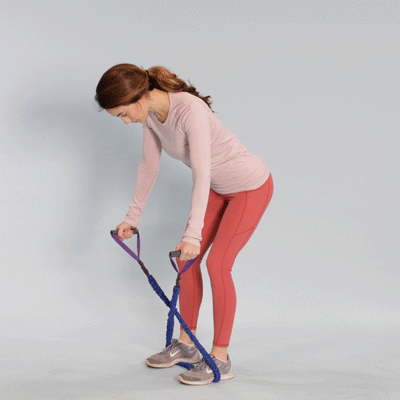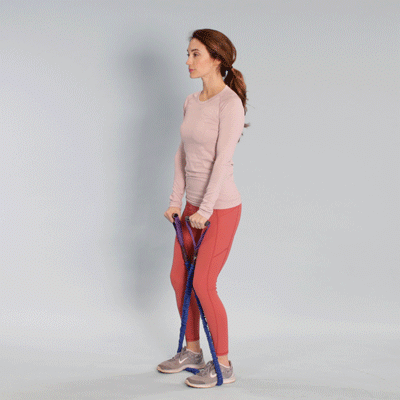If you’re interested in a simple way to do exercises for your shoulders, a resistance band may be the perfect fitness tool. Resistance bands are portable, convenient, and inexpensive, so you can carry a set with you when you’re on the go or traveling.
Resistance band exercises for shoulders are effective and simple to do, which means they’re accessible to a wide range of fitness levels and abilities.
You can easily add resistance band exercises to your current workout regimen or use them to create a new exercise routine that will provide a new challenge.
These exercises will help improve shoulder mobility and work some muscles that are important for stability, such as those in the rotator cuff. Read on to learn how to do resistance band exercises for your shoulder muscles, as well as some benefits of resistance band training.
For best results
For each exercise, do 1–3 sets of 8–15 repetitions, or modify this as directed by your doctor, physical therapist, or personal trainer.
Perfect the movements with a lighter resistance band before moving on to a heavier band. Use slow, controlled movements. Avoid rocking, swinging, or using momentum.

This exercise strengthens your shoulders, upper back, and upper arms. It helps improve posture and is beneficial for people who sit or do forward-bending movements often.
- Stand on the middle of the band.
- Cross the ends to opposite hands, so the band crosses in front of your lower legs.
- Hinge at your hips as you bend forward slightly, keeping your spine long and neutral, and maintain a slight bend in your knees throughout the movement.
- Pull the band upward and out to the sides until your hands are at chest height or higher.
- Draw your shoulder blades together.
- Hold this position for a few seconds.
- Slowly return to the starting position.

This exercise strengthens your anterior (front) shoulders. To promote proper posture, draw your shoulder blades down, elongate your spine, and engage your abdominals.
- Stand on the middle of the band and hold each end in the opposite hand, so the band crosses in front of your lower legs.
- Place your palms on your thighs.
- Raise your arms straight up in front of you, stopping when they’re at shoulder height. Try to avoid swinging or rocking backward as you raise them.
- Pause before slowly returning to the starting position.

This exercise targets your shoulders, upper back, and core muscles.
- Stand in the middle of the band.
- Hold each end of the band in the opposite hand with your palms facing inward and the band crossed in front of your lower legs.
- Maintain a slight bend in your elbows as you raise your arms to the sides.
- Pause for a few seconds with your arms slightly higher than shoulder height.
- Slowly return to the starting position.
This exercise targets your lats and rhomboids, as well as your middle and lower trapezius. Draw your shoulder blades together as you complete the movement. Avoid hunching your shoulders and keep your neck relaxed.
- Anchor the resistance band around a doorknob or secure object.
- Grasp a handle in each hand, keeping your forearms parallel to the floor.
- Bend your elbows to move your arms straight back to the sides of your ribs. Take care not to arch your back or thrust your ribs forward.
- Slowly return to the starting position.
This exercise works your rear shoulders and upper back, helping to correct and prevent rounded shoulders. It also improves shoulder stability, which helps you perform overhead movements.
This exercise is ideal for people who do activities that cause them to hunch forward. Moving your hands closer together on the band will increase the resistance.
- Hold the band and extend your arms straight out in front of you.
- Lengthen your spine and keep your elbows slightly bent.
- Pull the band apart as far as you can.
- Draw your shoulder blades together.
- Hold this position for a few seconds.
- Slowly return to the starting position.
This exercise targets your shoulders, back, and triceps. It improves stability, mobility, and posture.
- Hold the band straight above your head.
- Pull the band apart as your lower your arms to shoulder height, pressing your hands out to the sides.
- Hold this position for a few seconds.
- Slowly return to the starting position, aiming to keep your shoulder blades down, away from your ears.
Resistance band training provides a wealth of benefits. You can add these exercises to your fitness routine on their own or in addition to exercises using weights.
Safe and low impact: Ideal for shoulders
This safe, low impact option is especially ideal for complex joints such as the shoulders since they’re prone to injury. Without the need for gravity, you can apply resistance at any angle, which allows you to focus on specific areas and a range of degrees of rotation.
Doing gentle exercises to build strength, stability, and mobility can help you maintain the health of your shoulders and prevent injury (
Can be modified to suit individual needs
Resistance bands become more resistant as you stretch them. This makes the exercises more difficult as the bands get stretched and easier when there’s more slack.
As such, it’s easy to modify the intensity of a movement. You can modify the resistance level to suit your needs.
Portable, inexpensive, and easy to use
Resistance bands are portable, inexpensive, and easy to use, so you can easily incorporate them into your fitness routine. They also allow for plenty of variation and modifications.
Resistance band exercises can help improve flexibility and function and correct muscle imbalances. Plus, they may help relieve back or shoulder pain, especially after an injury or surgery, so you can go about your day in greater comfort.
If you’re using these exercises after an injury or surgery, be sure to consult your healthcare team first.
There are lots of options for resistance bands if you’d like to purchase your own. Here are some things to consider:
- how and where you’d like to use the bands
- the type of resistance you want
- features you may find useful, such as handles
You can find more information about resistance bands and popular options in this 5 Bands for Resistance Training article.
Resistance band exercises are an efficient and safe way to strengthen and increase flexibility in your shoulders and rotator cuffs.
Have fun adding them to your workout routine, and seek the guidance of a physical therapist, doctor, or personal trainer if you’d like support or have any medical conditions.
Discontinue your practice if you experience any pain or discomfort, especially if you’re healing from an injury.
